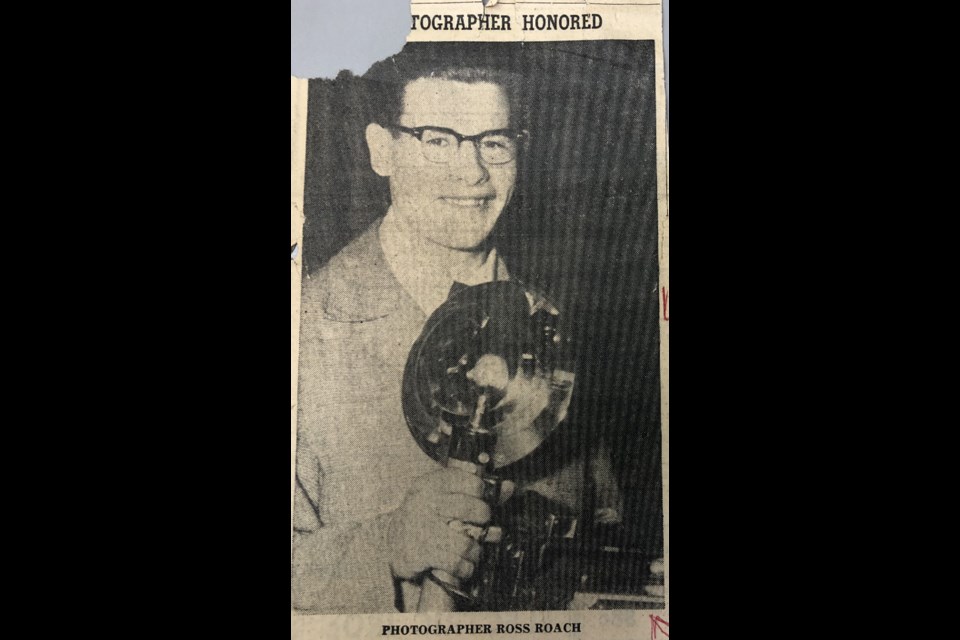MOOSEJAWTODAY.COM — While the mid-air collision over Moose Jaw on April 8, 1954, was tragic for the community, a photographer with the Times-Herald was heralded for a picture he took of one scene.
About a month after the disaster, The Canadian Press (CP) judged a photo by Ross Roach as the “Picture of the Month.” The national organization selected the photo from 207 other pictures it had issued during April.
Gillis Purcell, CP’s general manager, made the announcement in Toronto on May 13, 1954.
Published in two editions of the Times-Herald on April 8, the picture showed a flaming engine of the Trans-Canada Airlines plane beside the ruins of the Gordon Hume home. After colliding with an airbase Harvard trainer, the passenger plane’s fuselage fell on Hume’s home and destroyed it while also killing cleaner Martha Hadwen.
Roach joined the Times-Herald in 1953 “as an enthusiastic amateur photographer,” the newspaper said. He took the picture with a 4x5 Speed Graphic camera with an exposure of 1/200th at F-8. He also used a red filter and Super XX sheet film.
By taking Canada’s best news photo for the month, the photojournalist received $25.
After the incident, CP transmitted the picture to the Associated Press, a CP affiliate in the United States, by wire photo transmitter set up in the Times-Herald offices on the evening of April 8 and air-mailed to Canadian newspapers, appearing in nearly every newspaper and news magazine in the U.S. and Canada.
Time magazine also featured the award-winning photo.
Roach and Murray Banks, another staff photographer, made 400 prints of 13 pictures for CP on the day of the crash and the following day. However, the limited number of drying machines necessitated the use of drying equipment in a commercial studio, along with a makeshift drying apparatus set up on radiators.
After creating the prints, the men bundled them into envelopes and rushed them by car to Regina at 1 a.m. on April 9 to catch planes that would distribute them across Canada.
“The visiting newsmen, photographers and wire-photo men were most appreciative of the job that had been done by the Times-Herald staff, and the Canadian Press on behalf of all the newspapers in Canada has poured a whole bucket of praise over us,” an editorial said days afterward.
“All this only goes to show that newspapermen, while they work and grumble, have always a tremendous reserve up their sleeves and they know how to use it.”
Mother possibly sees lost son
While the mid-air disaster killed 37 people, there may have been a bright side for a West Coast family.
A photograph of the wreckage revived a Vancouver mother’s hope that her son, believed to have drowned in Moose Jaw in July 1952 and whose body was never found, might still have been alive.
Mrs. Jack Sedman told the media that she believed she recognized her son, Owen James Sedman, in a newspaper photo of a wreckage scene. She said a young man shown looking at the debris “bore a marked resemblance” to her son, who would then have been 19.
Mrs. Sedman said she would attempt to meet the young man to determine if it was her son.
The young man, one of 13 onlookers at the scene, was not identified in the photograph that the Times-Herald took.
There was no indication whether the mother met the young man or whether he was her son.
Money, money, money
Two days after the incident, the Moose Jaw Red Cross Society announced that it had collected $14,288.52 in donations and would continue for a while longer, officials said.
Some donors included J.E. Overs Ltd., with $25, Jas. Richardson and Sons with $50, Turner and Ellis with $10, Moose Jaw Hardware with $35, Blackwood Hardware with $25, Henderson Agencies with $15, Western Implement Co. with $28, Western Grocers with $29, community dentists with $110, city hall with $42, and Woolworth Ltd. with $8.50.
However, not all money related to the crash was positive.
William Sweny, a respected industrialist and businessman in Vancouver, left a gross estate of $738,764 when he died in the collision. His new wife of a few months, Jeanne Nelson, was also killed.
The industrialist left a bequest of $3,000 to his former secretary, Margaret Russell, and divided the bulk of his estate among his wife and two children — daughter Anne Garnett of West Vancouver and son David Sweny of Toronto. Mrs. Sweny’s share was divided between her kids.
Of the $317,533 insurance, $8,774 went to William’s former wife, Dorothy Sweny of Vancouver.




